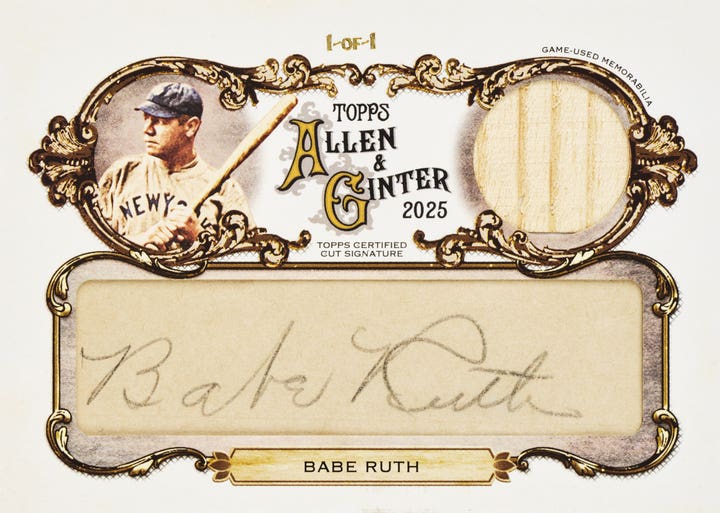Joe DiMaggio
The 1943 M.P. & Co. baseball issue is one of a handful from World War II
By Doug Koztoski
Dropping out of the clouds as they also slogged through the fog of war, U.S. paratroopers deployed their parachutes, did all they could to land safely and then carry out their missions.
It was mid summer 1943. No one knew it then, but it was quickly approaching the halfway mark of the United States’ involvement in World War II and paratroopers were one of the facets the U.S. had in its arsenal.
At the same time on the home front, other parts of the arsenal were in motion. The War Production Board, for instance, looked to motivate children to become “Paper Troopers,” where they gathered loads of paper, with certain amounts earning “P.T.” certificates and patches. The fact that paratroopers and “paper troopers” had a similar sound was no fluke.
Some of that collected paper, no doubt, entered the process as sports cards from the previous decade or two, if not older. How many from the Goudey, Play Ball and other sets met their fate at this time will never be known. New sports card sets during this era were sparse.
In 1943, however, M.P. & Company did produce a baseball card set. The initials stood for Michael Pressner, and his New York City-based firm made novelty and carnival supplies.
In its own way, the ’43 “MPs” are both novelty and carnival experience. The novelty element is largely that it is one of the few wartime sports card sets. The carnival component comes from the oddly drawn, colorful cartoon-like cards grabbing your attention, much like the carnival insult artist who sits atop the seat at the dunking booth and heckles prospective patrons to try and sink him, by hitting the bull’s-eye target, at three throws of a baseball for a dollar or more. For a moment or two one just has to stop and look.
Stu Speckman has stopped and looked at the 1943 M.P. & Co. set off and on for some four decades.
“I started to collect it seriously about three or four years ago, picking up a card here and there,” Speckman said.
He had the better samples graded and those have helped anchor him in the issue’s top spot on the PSA Set Registry.
What keeps the collector coming back to the 1943 offering?
“The overall goofiness attracts me,” he said. “The artwork is crude, the paper quality is low and the print on the back is often blurry. I just love the little things.”
Toss a few variations in the mix of one kind or another and this set becomes even more of a curiosity.
Originally produced in strips of eight and routinely sold at candy counters, what this 24-card set lacks in overall looks it largely makes up for in its star ratio, with over half of the set delivering Hall of Famers. The lineup includes: Lou Boudreau, Joe Cronin, Bill Dickey, Joe DiMaggio, Bob Feller, Jimmy (sic) Foxx, Hank Greenberg, Carl Hubbell, Joe Medwick, Johnny Mize, Mel Ott, “Pee Wee” Reese, “Red” Ruffing and Ted Williams, the set-ender.
Several of those players, of course, served in the military in the war, with Feller being the first big leaguer to join the service, just days after the attack on Pearl Harbor in December 1941.
While Speckman has owned several of the ’43 DiMaggio cards, he picks the Williams and the Hubbell pasteboards as his favorites in the issue. The sports card enthusiast said the Ruffing and Ernie Bonham, the set-starter, have been “super hard for me to find and I am not sure why.”
Another cut at the ball
In 1949 M.P. & Co. came out with a bit of a re-issue of their 1943 set. Not all of the players were the same from the previous offering, naturally, but DiMaggio, Feller, Reese and Williams were still playing and all made it into this second go-round.
Two new players of note in this ’49 collection: Yankees catcher Larry “Yogi” Berra and Cleveland outfielder Larry Doby. Doby had the distinction of integrating the American League in 1947, a few months after Jackie Robinson integrated MLB, with the Brooklyn Dodgers.
When compared side-by-side, at a glance, some of the images of certain players in the set are the same, or very similar, in both groupings. The easiest way to tell the difference between the issues is that the 1949 set is numbered, starting with #100 (Boudreau). Also, the biographies on the backs can help determine which set they originated from.
One 1943 card that transitioned into the 1949 issue is worth a closer look, on many fronts. The ’43 Johnny Vander Meer has the pitcher’s uniform number as 57, a number he wore only in 1938.
“His number in 1943 was 33,” Speckman said. “The same image is used for Larry Doby in the 1949 set. However, Vander Meer is white and Doby is black (some effort was made to give the Doby image an appropriately darker skin tone).”
Plus, Doby threw right-handed, opposite of Vander Meer. “Finally, “ Speckman noted, “Doby’s uniform number in 1949 was 37, not 57.”
A case of quality control gone AWOL.
Soldiering on
Much like the basic design of the issues, Speckman said their overall popularity is limited.
“The 1943 set is actively collected on the (PSA) Registry by just ten folks,” he said. “That is very, very low.”
The 1949 set has only a single collector on that Registry.
“The cards sell, but not for crazy high prices,” he said. “Though the 1949s are more rare, and, thus, more expensive.”
As to both issues’ future?
“The big gun cards will always sell,” Speckman said, “but not too many people will collect the sets, relatively speaking.”
One could say Speckman and a handful of others are modern day “paper troopers,” in a way, with respect to the 1940s M.P. & Company sets, collecting them not for war effort recycling, obviously, but to enjoy now and, hopefully, for many others to explore for generations to come.
If nothing else, floating even a few cards from the M.P. & Co. sets, the 1943 issue in particular, into one’s collection connects a pasteboard hobbyist to another distinct era, a time when many sacrificed on the battlefield and on the home front, and very few sports card offerings earned their stripes.
Doug Koztoski is a frequent contributor to Sports Collectors Digest. He welcomes comments and questions related to this article at dkoz3000@gmail.com.








